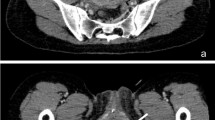Abstract
Background and aims
Dynamic graciloplasty and artificial anal sphincter are two options for refractory incontinence, the efficacy of which was compared in a prospective study.
Patients and methods
Between November 1966 and June 1998, 16 patients were operated on (artificial anal sphincter 8, dynamic graciloplasty 8). Four consecutive operations with each technique were performed by two colorectal surgeons (one initiated the study with the neosphincter and the other with dynamic graciloplasty). Two independent observers assessed postoperative results at 4-month intervals. Patients were followed up to January 2001, with a median (interquartile range) of 44 (13) months and 39 (15) months for the nesophincter and the dynamic graciloplasty, respectively.
Results
Fourteen patients had complications. In the immediate postoperative period; there were eight cases of wound healing-related problems (four in the graciloplasty group). Perineal infection occurred in one patient in the graciloplasty group. At follow-up there were 11 complications (6 in the neosphincter group). Four patients undergoing neosphincter implantation had erosion or pain at the cuff site and had the implant removed (a new device was reimplanted in one). Four patients undergoing dynamic graciloplasty had the stimulator removed. Postoperatively the neosphincter was associated with a significantly lower score on the continence grading scale of the Cleveland Clinic Florida than graciloplasty.
Conclusion
The artificial anal sphincter is a more convenient technique than dynamic graciloplasty for institutions treating small number of patients. However, technical failures and complications during follow-up that require reoperation are very high in both types of treatments.

Similar content being viewed by others
References
Baeten GCMI, Bailey HR, Bakka A, Belliveau P, Berg E, Buie WD, et al (2000) Safety and efficacy of dynamic graciloplasty for fecal incontinence. Report of a prospective multicenter study. Dis Colon Rectum 43:743–751
Lehur PA, Roig JV, Duinslaeger M (2000) Artificial anal sphincter. Prospective clinical and manometric evaluation. Dis Colon Rectum 43:1100–1106
Madoff RD, Baeten CGMI, Christiansen J, Rosen HR, Williams NS, Heine JA, et al (2000) Standards for anal sphincter replacement. Dis Colon Rectum 43:135–141
Jorge JMN, Wexner SD (1993) Etiology and management of fecal incontinence. Dis Colon Rectum 36:77–97
Baeten CGMI, Konsten J, Spaans F, Visser R, Habets AMM, Bourgeois IM, et al (1991) Dynamic graciloplasty for treatment of faecal incontinence. Lancet 338:1163–1165
Lehur PA, Michot F, Denis P, Grise P, Leborgne J, Teniere P, et al (1996) Results of artificial sphincter in severe anal incontinence. Report of 14 consecutive implantations. Dis Colon Rectum 39:1352–1355
Malouf AJ, Vaizey CJ, Kamm MA, Nicholls RJ (2000) Reassessing artificial bowel sphincters. Lancet 355;2210–2220
O'Brien PE, Skinner S (2000) Restoring control: the Acticon Neosphincter artificial bowel sphincter in the treatment of anal incontinence. Dis Colon Rectum 43:1213–1216
Vaizey CJ, Kamm MA, Gold DM, Bartram CI, Halligan S, Nicholls RJ (1998) Clinical, physiological, and radiological study of a new purpose-designed artificial bowel sphincter. Lancet 352:105–109
Wong WD, Jensen LL, Bartolo DCC, Rothenberger DA (1966) Artificial anal sphincter. Dis Colon Rectum 12:1345–1351
Dodi G, Melega E, Masin A, Infantino A, Cavallari F, Lise M (2000) Artificial bowel sphincter (ABS) for severe faecal incontinence: a clinical and manometric study. Int J Colorectal Dis 2:207–211
Madoff RD, Rosen HR, Baeten CG, LaFontaine LJ, Cavina E, Devesa M, et al (1999) Safety and efficacy of dynamic muscle plasty for anal incontinence: lessons from a prospective, multicenter trial. Gastroenterology 116:549–556
Mander BJ, Wexner SD, Williams NS, Bartolo DC, Lubowski DZ, Oresland T, et al (1999) Preliminary results of a multicentre trial of the electrically stimulated gracilis neoanal sphincter. Br J Surg 86:1543–1548
Mavrantonis C, Wexner SD (2000) Stimulated graciloplasty for treatment of intractable fecal continence. Critical influence of the method of stimulation. Dis Colon Rectum 42:497–504
Savoye G, Leroy AM, Denis P, Michot F (2000) Manometric assessment of an artificial bowel sphincter. Br J Surg 87:586–589
Acknowledgements
We thank Marta Pulido, M.D., for editing the manuscript and editorial assistance.
Author information
Authors and Affiliations
Corresponding author
Rights and permissions
About this article
Cite this article
Ortiz, H., Armendariz, P., DeMiguel, M. et al. Prospective study of artificial anal sphincter and dynamic graciloplasty for severe anal incontinence. Int J Colorectal Dis 18, 349–354 (2003). https://doi.org/10.1007/s00384-002-0472-x
Accepted:
Published:
Issue Date:
DOI: https://doi.org/10.1007/s00384-002-0472-x




